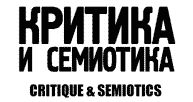HOW TO GO BEYOND THE WALLS OF THE ACADEMY AND RETURN?
DOI: 10.23951/2312-7899-2020-1-93-103
The city as one of the most important phenomena of the modern globalized world is the subject of investigations of various scientific disciplines. It is important phenomena for studies on the history of civilization, on urbanization processes, on the development of architecture, on the relationships between spatial planning and religious and political ideas, for studies on social and economic changes, for studies on urban ways of life, studies on the history of art, as well as critique of contemporary art. There are also elementary analyzes of a city in the field of literary studies, sound studies, performance studies, psychology (the perception of space and its properties), pedagogy, political science (interested in direct democracy or even urban movements). The issues of optimization of models of the city’s functioning are important for departments oriented on transport and infrastructure (water, gas etc.), as well as underground construction (car parks, garages, tunnels, metro). Informatics dealing with the process of creation of new communication technologies is involved in the design of “smart city”. The faculties of biology or environmental protection conduct research and didactic activities in the field of “applied ecology” – relations that occurring between the human environment and nature. Today technological innovation and creative power of culture are the key to the development of the city. However, what does it mean for the representatives of humanities? What can they bring to it? The city space then appears as a heterogeneous place, full of constant tensions, collisions, circulation of meanings, values, representations, as well as the field of great social experiments. I perceive the human practices and creations as something that is a subject to constant transformation and that constantly requires new readings. In my search, I often go beyond the walls of the academy and try to sense the character of the city and experience its space with all my senses. I keenly observe the ways of life of the inhabitants, their daily practices. I listen to what they say and read what they manifest on the walls of buildings. This peculiar wandering around the city is aimed at capturing what is visible, but also at reaching what remains inaccessible to us at first glance. It is a collection of notes, it is an attempt at visual and audio recording of the surrounding world, which I then try to structure and interpret. However, as experts, we academics need to “go out” to the city also in a different way – we must take the floor in public debates and have an influence on the decisions of various municipal institutions, have an impact on local politics. There is a discussion about the role of the university in shaping urban space and life in the city.
Keywords: visual studies of urban culture, academy, university, scientific disciplines, culture, city, urban space, daily practices, flaneur, ocularcentrism, conceptual rationalism, politics.
References:
Benjamin, W. (1999) The Arcades Project. Transl. into English by H. Eiland, K. McLaughlin. Cambridge MA, London.
Buczyńska, H. (1963) Cassirer. Warsaw.
Dietzsch, S. (2005) Immanuel Kant. Biografia. Transl. into Polish by K. Krzemieniowa. Warsaw.
Fereński, P. J. (2018) Matter of Culture. Heteronomies of Life of the Inhabitants of Modern Cities. Gdańsk.
Fisher, M. (2009) Capitalist Realism. Is There No Alternative? New Alresford.
Gordon, P. E. (2010) Continental Divide: Heidegger, Cassirer, Davos. Cambridge.
Jay, M. (1993) Downcast Eyes. The Denigration of Vision in Twentieth-Century French Thought. Berkeley.
Kant, I. (2003) The Critique of Pure Reason. Transl. into English by J. M. D. Meiklejohn. The Project Gutenberg EBook of The Critique of Pure Reason. [Online] Available from: http://www.gutenberg.org/files/4280/4280-h/4280-h.htm
Sudjic, D. (2017) Język miast. Transl. into Polish by A. Sak. Cracow.
Issue: 1, 2020
Series of issue: Issue 1
Rubric: ARTICLES
Pages: 93 — 103
Downloads: 584










